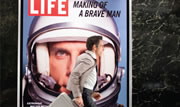
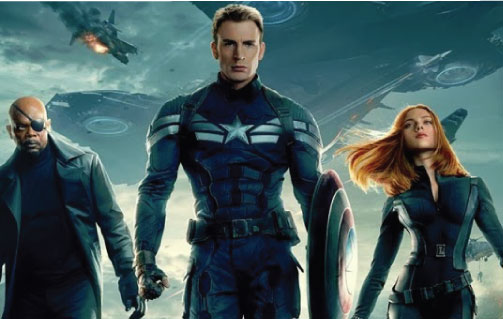 Scarlett Johansson makes her third on-screen appearance as Natasha Romanoff, a.k.a. Black Widow, in CAPTAIN AMERICA: THE WINTER SOLDIER, arriving April 4, 2014, which is reason enough to take a look back at the rise of the female action hero. The Widow originally wove her way into the MARVEL universe as Natalia Alianova Romanova in 'Tales of Suspense' #52 (April 1964) written by Stan Lee and Don Rico, and illustrated by Don Heck. Her screen debut in IRON MAN 2 (2010) played to her character's strengths as undercover S.H.I.E.L.D. agent Natalia Rushman, irking the too- clever-for-his-own-good Tony Stark (Robert Downey Jr.). THE WINTER SOLDIER further developed The Widow as a superspy assassin who delivers a smack down comparable to her male counterparts.
Scarlett Johansson makes her third on-screen appearance as Natasha Romanoff, a.k.a. Black Widow, in CAPTAIN AMERICA: THE WINTER SOLDIER, arriving April 4, 2014, which is reason enough to take a look back at the rise of the female action hero. The Widow originally wove her way into the MARVEL universe as Natalia Alianova Romanova in 'Tales of Suspense' #52 (April 1964) written by Stan Lee and Don Rico, and illustrated by Don Heck. Her screen debut in IRON MAN 2 (2010) played to her character's strengths as undercover S.H.I.E.L.D. agent Natalia Rushman, irking the too- clever-for-his-own-good Tony Stark (Robert Downey Jr.). THE WINTER SOLDIER further developed The Widow as a superspy assassin who delivers a smack down comparable to her male counterparts.
Now MARVEL fans have a new reason to celebrate because on Valentine's Day reports surfaced of a BLACK WIDOW feature film in the making, which, if true, would bust through the long-standing barrier of male dominance in superhero action films. For those enamored of the idea of powerful female role models, we've lined up a squad of five action heroines, our favorites among those who paved the way for the Black Widow. How were they chosen? The Heroes montage presented at the 86th annual Academy Awards® presented by 'Captain America' himself, Chris Evans, was a good place to start. But we added Catwoman because we like the fact that she only came into existence when Max Schreck (Christopher Walken) tossed her out a window. Besides, she transcends the stereotype of the slinky, sexy femme fatale by confronting her oppressors. And we excluded the film X-MEN, which seemed less of a showcase for its traditionally strong female characters than the comic books that spawned them.
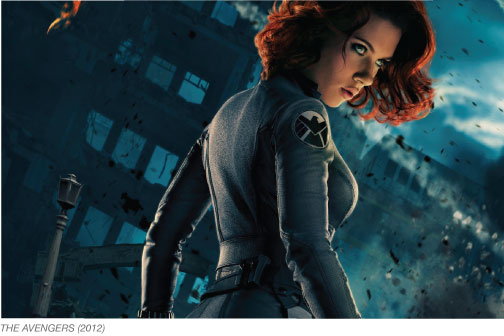 THE AVENGERS (2012) – NATASHA ROMANOV a.k.a BLACK WIDOW
THE AVENGERS (2012) – NATASHA ROMANOV a.k.a BLACK WIDOW
With her all-too-human leanings on cunning and deception, Black Widow is the epitome of a relatable superheroine. She conquers foes by using her intelligence, masking her malevolent intent with the pretense of vulnerability. Her strengths are not superhuman powers but well-polished skills of perception and control over her own emotions. As the name implies, Black Widow is a force of nature, one that packs a vicious bite from a seemingly innocuous host. Johansson never fails to stand out from the pack of bruiting male Superhero co-stars that surround her. She endures as a vortex of feminine strength within a male world.
In an interview with Entertainment Weekly, Scarlett Johansson opens up about why superheroine movies tend to pale in comparison to their male-driven counterparts: "I'd have to wear pasties to greenlight any of these movies... They're always fighting in a bra, so while it might be exciting for a still photo, it's ridiculous. One of the most exciting things about [THE AVENGERS] is that in my opening scene the first thing you see is my character getting punched in the face. Everybody's like, 'Damn, it's nice to see a girl get the s*** kicked out of her...Superheroine movies are normally really corny and bad. They're always like, fighting in four-inch heels with their [chest thrust out] like a two-gun salute."
That's the enlightened perspective that gives us high hopes for the Black Widow feature in development.
 ALIEN (1979) – Ellen Ripley
ALIEN (1979) – Ellen Ripley
At the time of its release, ALIEN's portrayal of nontraditional gender roles was quite a departure from what sci-fi and horror fans expected. Fun fact: In the original script titled, STAR BEAST, Ripley (Sigourney Weaver) was conceived as a man alongside an all-male crew. In the finished film, she is just as tough as her male prototype. Ripley acts as a hyper-realized Alice in Wonderland shattering the looking glass of the traditionally male universe of space exploration with its phallic symbol rockets and BARBARELLA fantasies. Her salvation, much like Alice's, comes from embracing her own valor and bravery and realizing that the only person who is coming to save her is herself. Director Ridley Scott had the foresight to develop a female protagonist, one that would stand out as an enduring female icon in the sci-fi action hero genre. And it's impossible to overlook the pre-eminent designs and set fabrications for ALIEN by the legendary Swiss surrealist artist H.R. Giger. Scott selected Giger's alien design, inspired by his earlier print Necronom IV, from his book "Necronomicon," for it's asexuality, granting a disturbing familiarity to the title creature, which is neither male nor female, man nor machine. It is worth noting that when writer David O'Bannon alludes to ALIEN as a story of "interspecies rape" in the documentary ALIEN EVOLUTION (2001), his comment is not about women as victims, but about a challenge to all mankind.
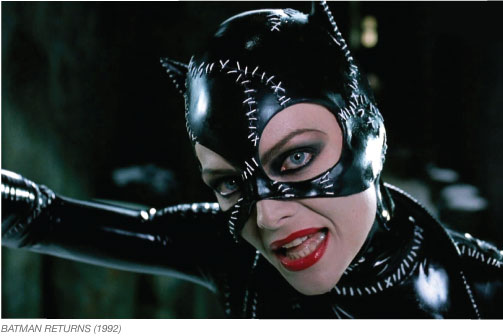 BATMAN RETURNS (1992) – Selina Kyle a.k.a Catwoman
BATMAN RETURNS (1992) – Selina Kyle a.k.a Catwoman
We would be remiss in celebrating Catwoman without tipping our hats to her precursors in the original BATMAN (1966-1968) television series portrayed by Lee Meriwether, Julie Newmar and Eartha Kitt. However, the performance that catapulted the fearless feline to the zenith of female-empowering performances is Michelle Pfeifer's in BATMAN RETURNS (1992). In homage to Helen Reddy's anthem for women's liberation "I am Woman" (1971), Catwoman first appears in the film when her alter ego, the meek and mild Selina Kyle, proclaims," I am Catwoman, hear me roar." Watching Kyle transform into Catwoman in BATMAN RETURNS was, for women, the equivalent of hearing, "We're mad as hell, and we're not going to take it anymore!" Through the rest of the film, Tim Burton's take on Catwoman flips the patriarchy on its head as the character makes sardonic remarks, projecting self-assured sexuality as she butts heads with men. Her key objective as the anti-hero is to disrupt the system that entrapped Selina Kyle. As she blazes through her nine lives, Catwoman remains a constant reminder of the double standard the hero of our story, Bruce Wayne/Batman, places on Kyle, the erstwhile damsel-in-distress. Catwoman's poignant last remarks to Batman before she sacrifices herself to preserve a shred of justice reveal her awareness of the oppression she faced until the very end: "Bruce, I would love to live with you in your castle forever just like in a fairytale... I just couldn't live with myself, so don't pretend this is a happy ending!"
 KILL BILL (2003) – Beatrix Kiddo a.k.a The Bride/Black Mamba
KILL BILL (2003) – Beatrix Kiddo a.k.a The Bride/Black Mamba
Quentin Tarantino's portrayal of the hero's journey led by the archetypal character of The Bride (Uma Thurman) opens with a brutality and violence rarely associated with a female-driven film. As part of an all-female clique of assassins, The Bride, aka Black Mamba, becomes the target of her jealous lover Bill's revenge plot. As she wakes from a coma induced by her former lover's bullet to her head, The Bride is bent on revenge. She has been resurrected with the purpose of avenging her death along with that of her unborn child, and will not stop until she destroys all her enemies. One tough mother, The Bride is also instilled with a vulnerability at odds with the vengeance she seeks, a combination not typical of male screen avengers.
The Bride exhibits compassion at various points in the film. Her reason for escaping Bill in the first place is to give her unborn daughter the sort of stable life currently undermined by her employment as an assassin. As she goes after her first target for revenge – Vernita (Vivica Fox) hiding out in a LEAVE IT TO BEAVER-like suburb – she attempts to protect her victim's young daughter from witnessing the brutality of her mother's death. When she fails to do so, she acknowledges the karma of revenge killing by telling the young girl to come find her when she's older if she's still upset about it. Finally, we witness The Bride's compassion when, after killing Bill with master Pai Mei's exploding heart technique, she grants him comforting last words. Killing with compassion and benevolence is what sets The Bride apart from previous action heroines.
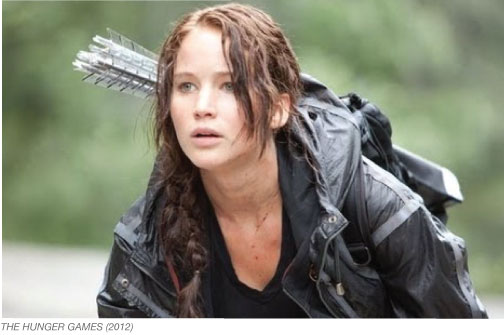 THE HUNGER GAMES (2012) – Katniss Everdeen
THE HUNGER GAMES (2012) – Katniss Everdeen
Katniss Everdeen (Jennifer Lawrence) leaps into action as Katniss Everdeen a 21st century heroine, revolutionizing gender roles in American cinema. Her acts of self-sacrifice – volunteering to replace her kid sister Primrose as a tribute from the 12th District of Panem during the 74th Hunger Games – led the way to revolution against the oppressive Capital. A skillful huntress who provided for her family after her father's death in the coal mines and her mother's descent into madness, Katniss defies society's rules and becomes a self-reliant woman who embodies the ideal of equality. We would be remiss in talking about THE HUNGER GAMES without taking note of it's remarkable achievements at the box-office disproving the long-standing belief that women cannot "open" a blockbuster film. Katniss (Jennifer Lawrence) is the girl on fire and the symbol of revolution in the fictional world of Panem, not to mention the one in American film. Nina Jacobson, the producer of THE HUNGER GAMES franchise, puts it this way: "She is a singular heroine in that the burden of survival weighs on her. She has a ton of survivor's guilt. And she keeps surviving."
|
|
|
|
|




